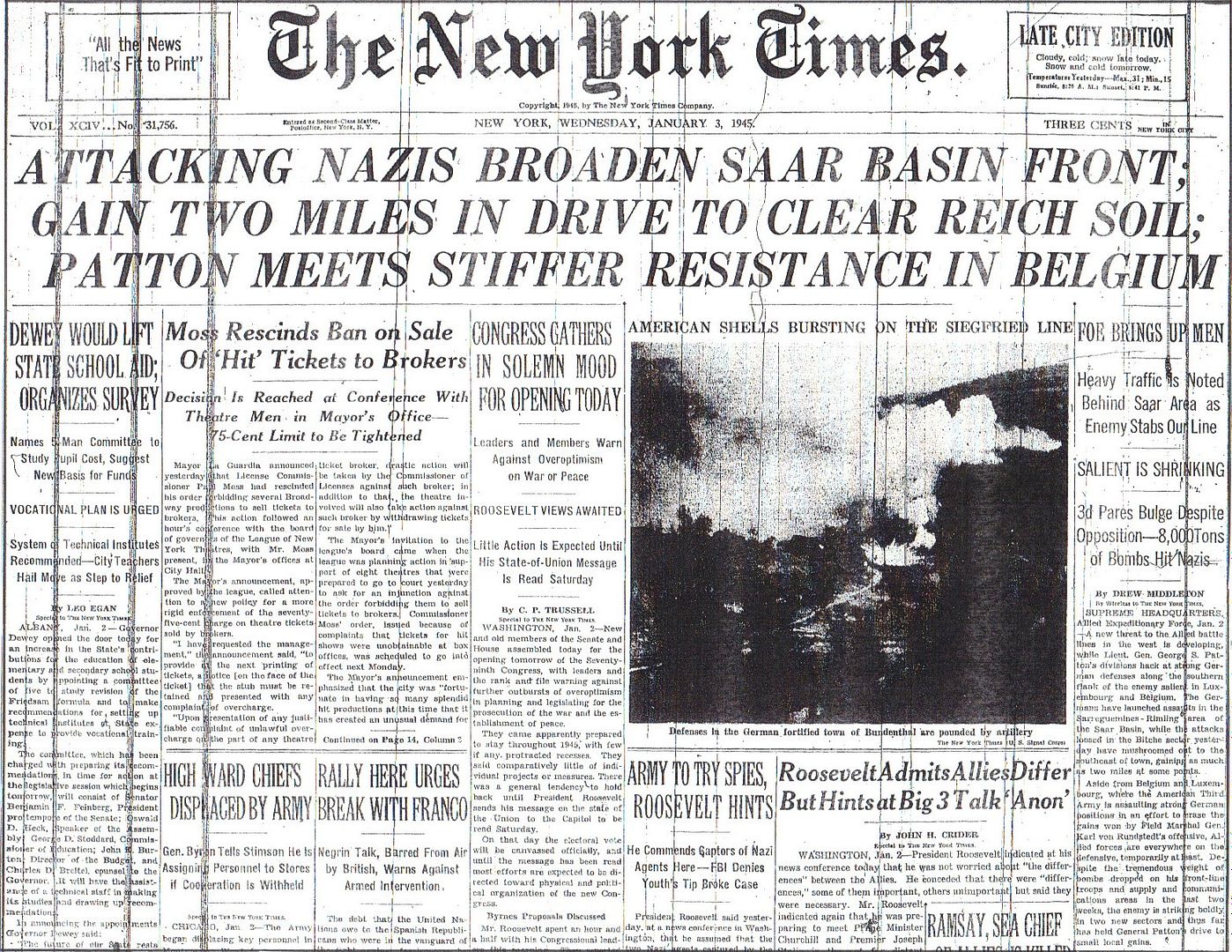
Posted on 01/03/2015 4:24:06 AM PST by Homer_J_Simpson

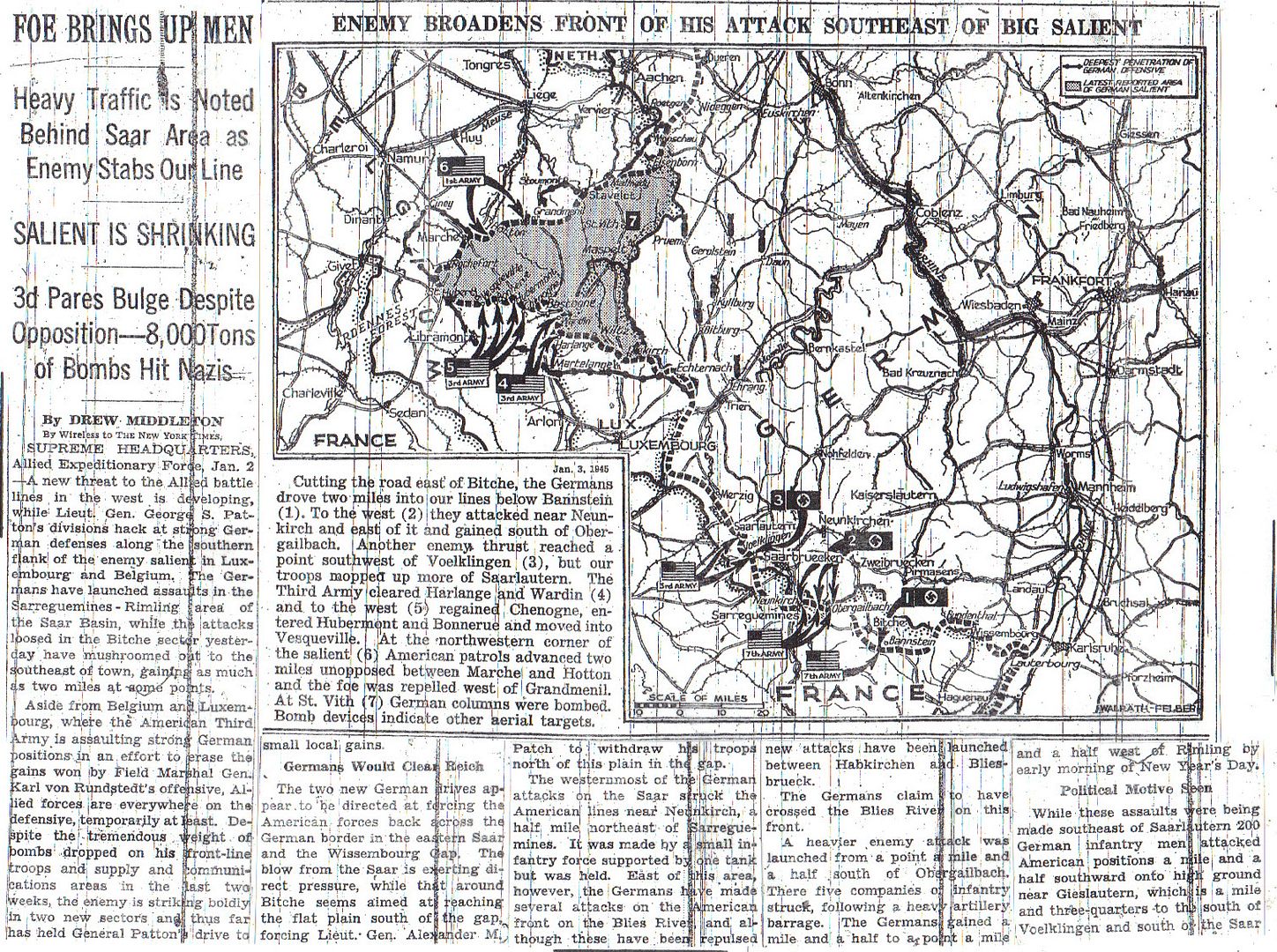
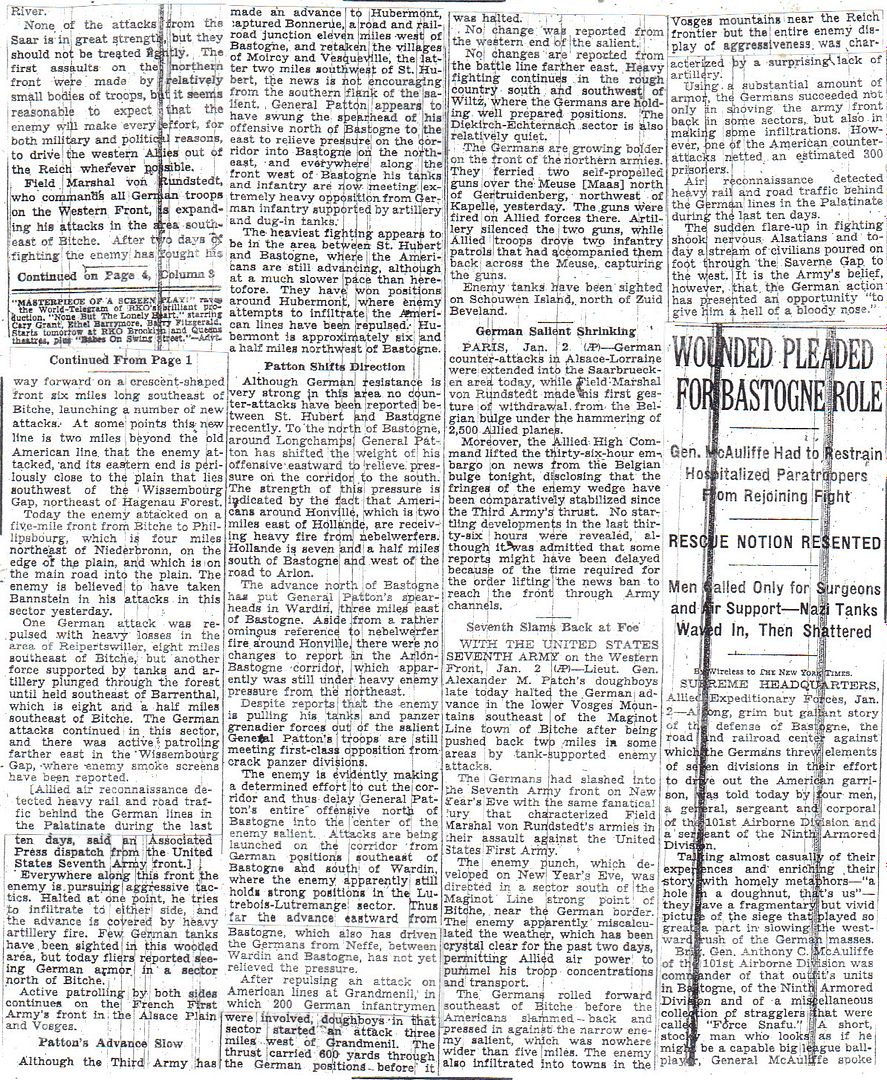
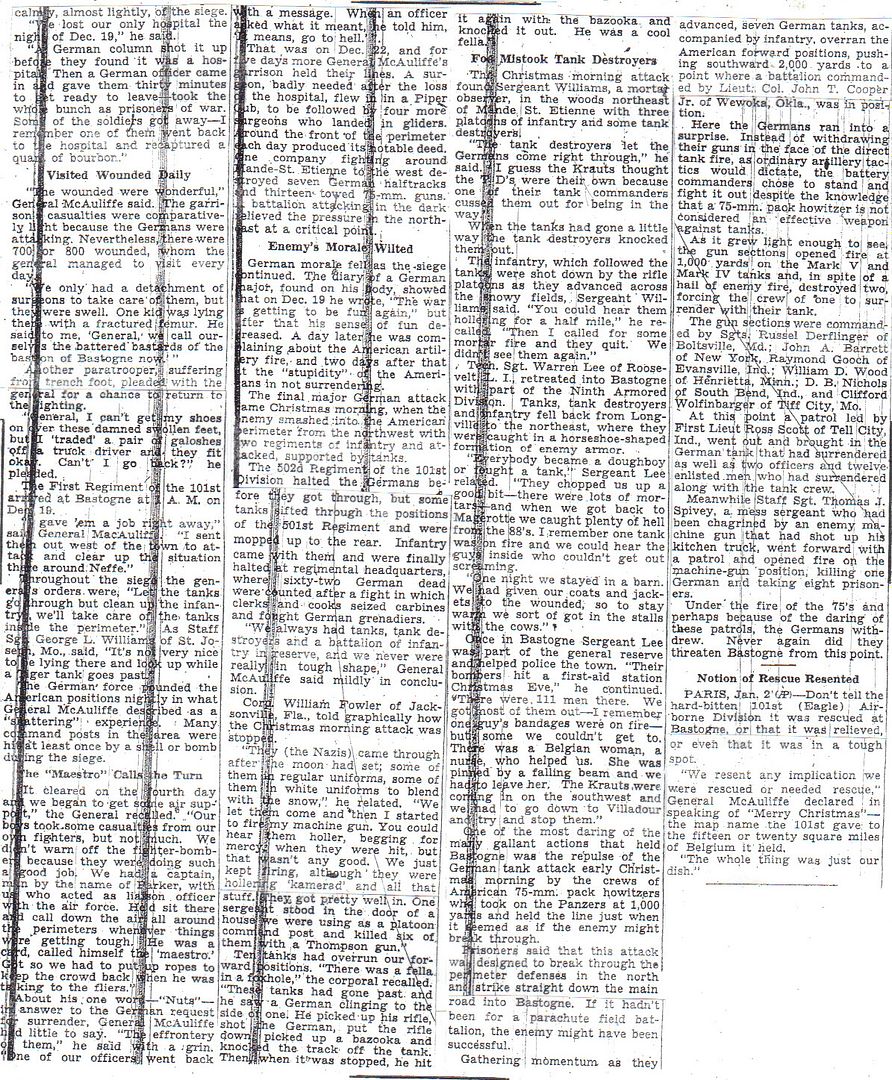
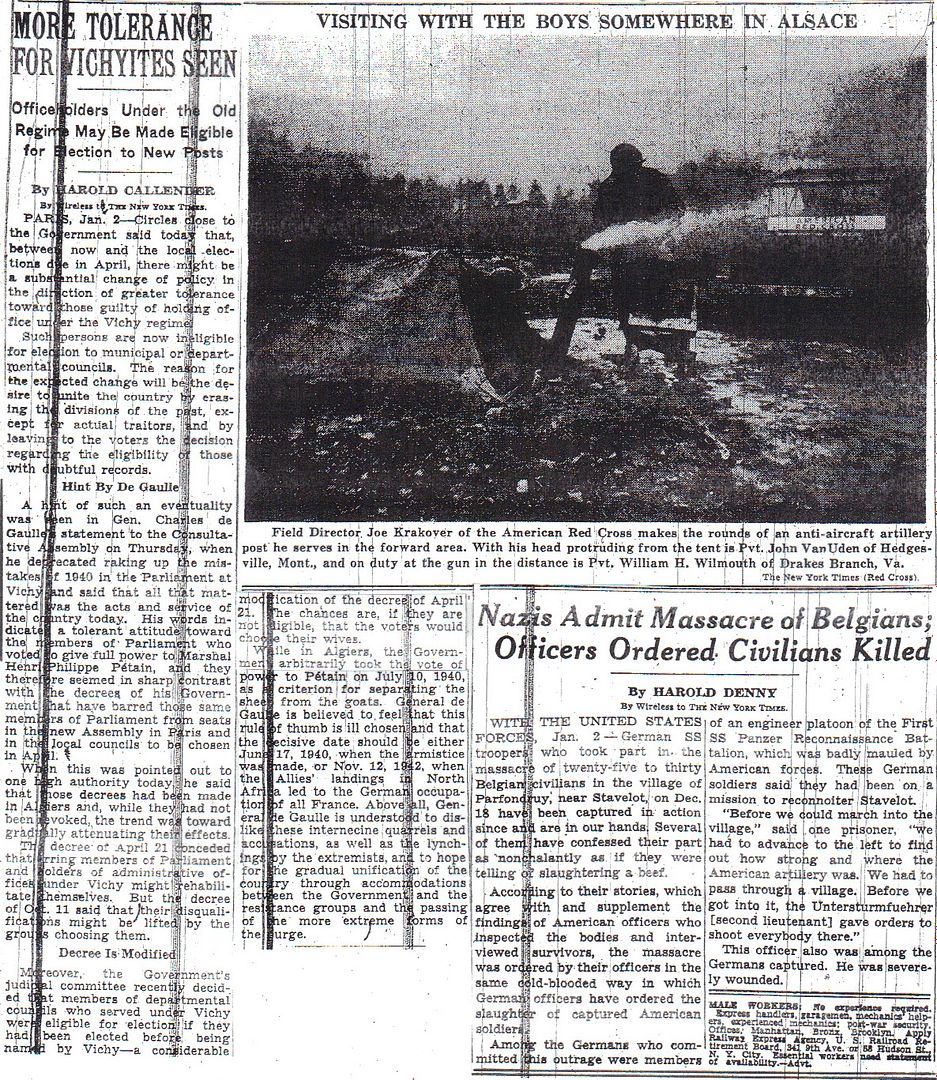
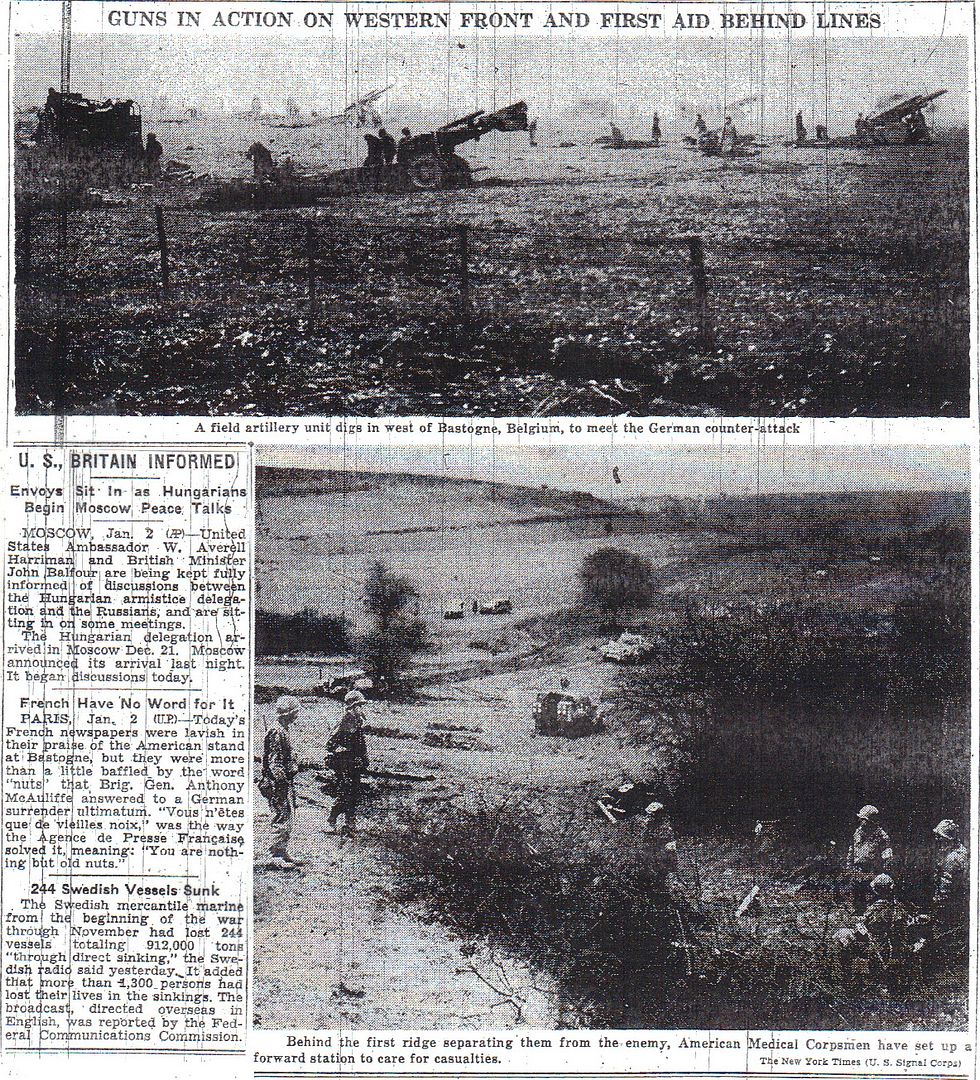
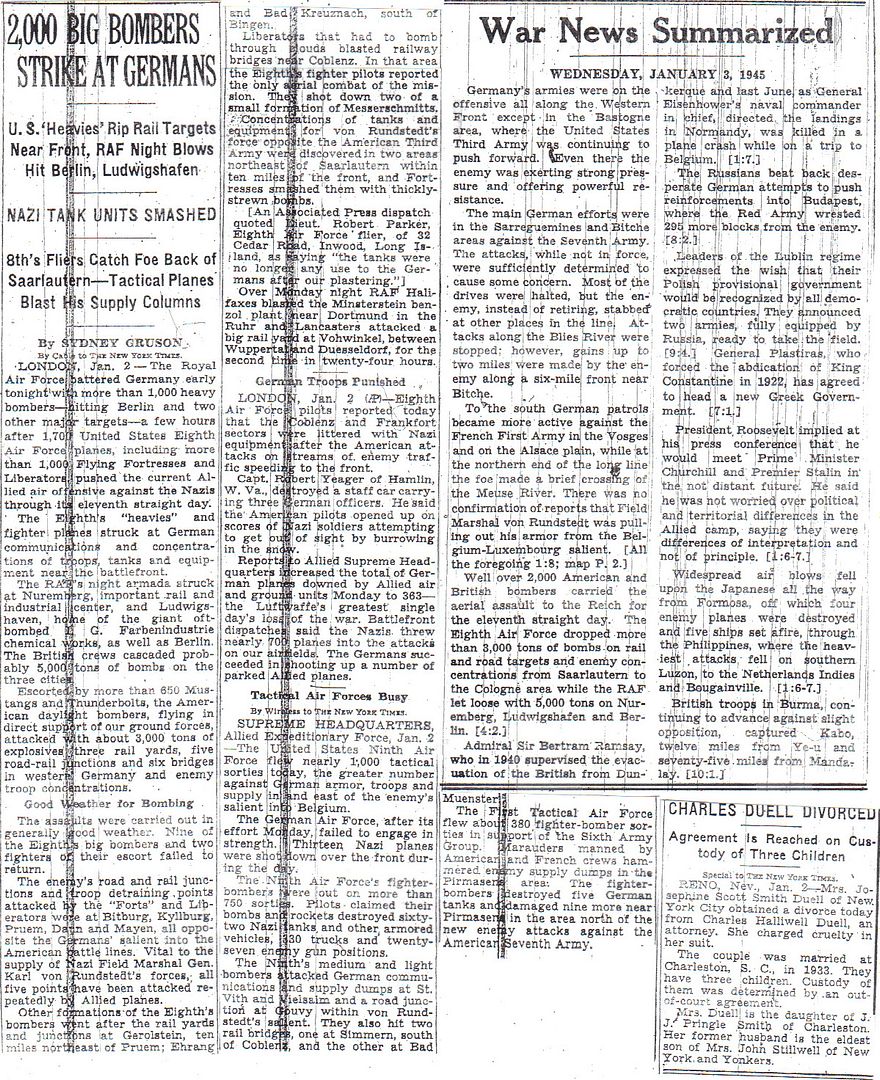

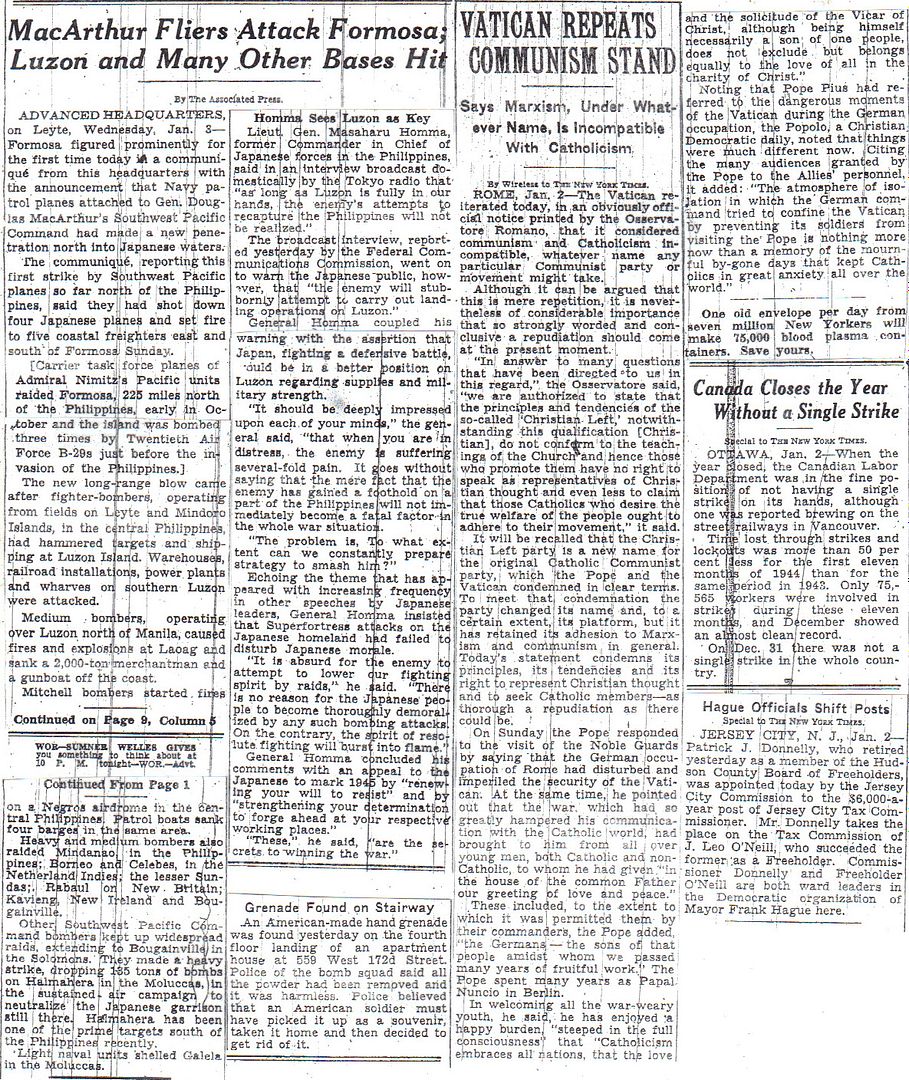
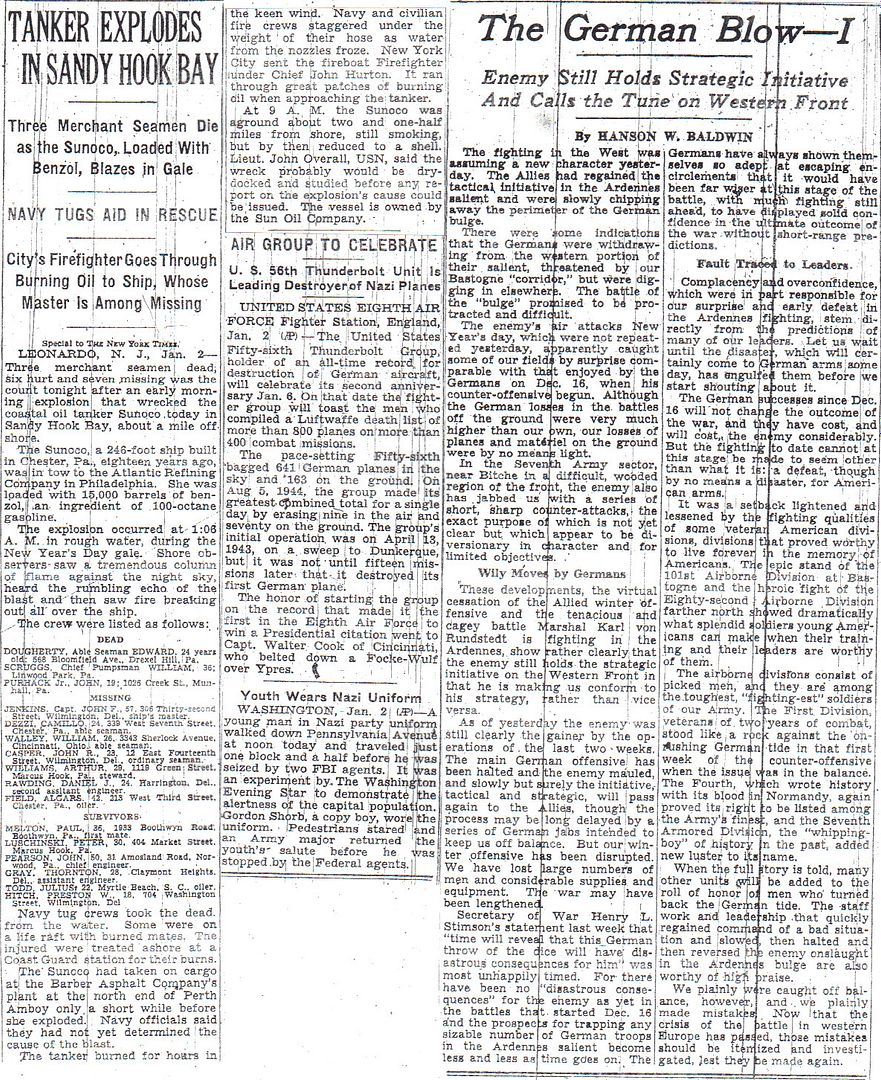
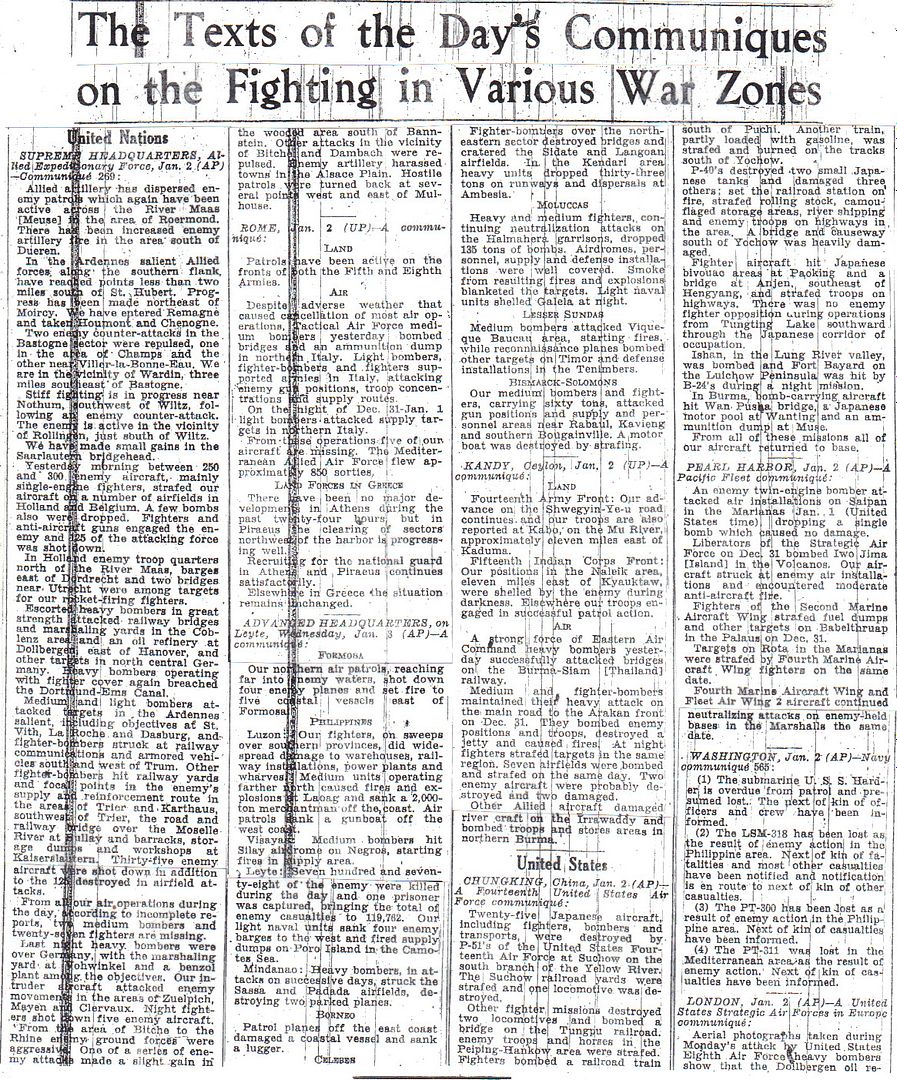
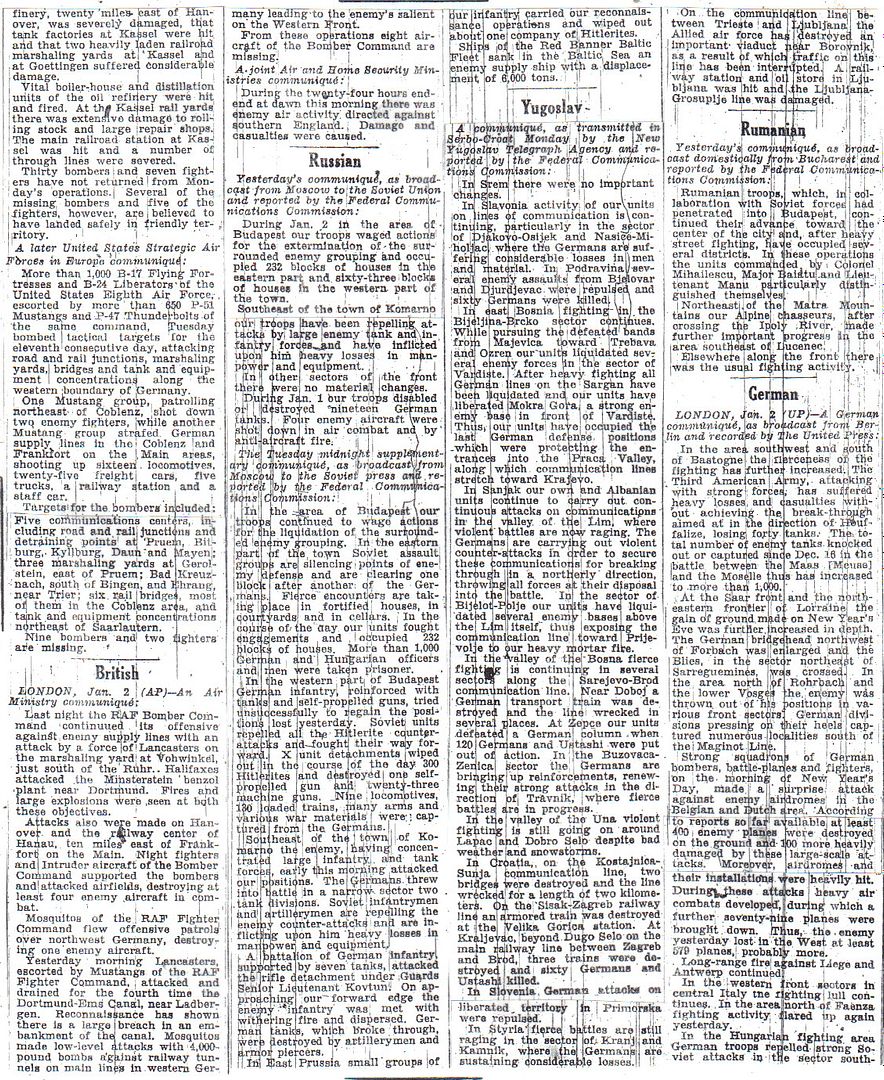

http://www.etherit.co.uk/month/0/03.htm
January 3rd, 1945 (WEDNESDAY)
FRANCE: Philippsbourg: Private First Class George B. Turner, U.S. Army, Battery C, 499th Armoured Field Artillery Battalion, 14th Armoured Division. Cut off from his artillery unit by an enemy armoured infantry attack. Coming upon a friendly infantry company withdrawing under the vicious onslaught, he noticed 2 German tanks and approximately 75 supporting foot soldiers advancing down the main street of the village. Seizing a rocket launcher, he advanced under intense small-arms and cannon fire to meet the tanks and, standing in the middle of the road, fired at them, destroying 1 and disabling the second. From a nearby half-track he then dismounted a machinegun, placed it in the open street and fired into the enemy infantrymen, killing or wounding a great number and breaking up the attack. In the American counterattack which followed, 2 supporting tanks were disabled by an enemy antitank gun. Firing a light machinegun from the hip, Pfc. Turner held off the enemy so that the crews of the disabled vehicles could extricate themselves. He ran through a hail of fire to one of the tanks which had burst into flames and attempted to rescue a man who had been unable to escape; but an explosion of the tank’s ammunition frustrated his effort and wounded him painfully. Refusing to be evacuated, he remained with the infantry until the following day, driving off an enemy patrol with serious casualties, assisting in capturing a hostile strong point, and voluntarily and fearlessly driving a truck through heavy enemy fire to deliver wounded men to the rear aid station. The great courage displayed by Pfc. Turner and his magnificently heroic initiative contributed materially to the defence of the French town and inspired the troops about him. PFC Turner was a 46 year old private. (Patrick Holscher)
In the U.S. Third Army’s VIII Corps area, the 28th Infantry Division defends the Meuse River from Givet to Verdun. In the III Corps area, the 6th Armoured Division repels German thrusts west of Michamps and places heavy artillery concentrations on Arloncourt, Michamps, and Bourcy. To the south, attempts to clear the high ground near Wardin and takes the road junction south of the town.
The 6th Army Group is assigned the defence of Strasbourg.
In the U.S. Seventh Army area, XV Corps, Combat Command L, French 2d Armoured Division, pushes into Gros Rederching but is unable to clear it. Attempt by the U.S. 44th Infantry Division to relieve the French there fails. The 36th Infantry Division (less Regimental Combat Team 141) assembles near Montbronn. In the VI Corps area, the Germans expands the Bitche salient, entering Wingen and Philippsbourg. The 45th Infantry Division withstands pressure against Reipertsweiler, northwest of Wingen, and contains attacks in the Sarreinsberg-Meisenthal area. Centre and right flank elements of corps complete withdrawal to Maginot positions.
BELGIUM: The U.S. First Army starts a counteroffensive to reduce the German’s Ardennes salient from the north. VII Corps attacks southeast toward Houffalize with the 2d Armoured Division followed by the 84th Infantry Division on the right, and 3d Armoured Division followed by 83d Infantry Division on the left. 2d Armoured Division gains Trinal, Magoster, positions in the Bois de Tave, Freineux, Le Batty, and positions near Belle Haie. The 3d Armoured Division takes Malempré and Floret and from the latter continues southeast on the Lierneux road to Groumont Creek. The 75th Infantry Division, after an attack passes through its line, continues mopping up south of Sadzot. In the XVIII Corps (Airborne) area, the 82d Airborne Division, in conjunction with the VII Corps’ attack, thrusts southeast, improving positions. As a diversion, the 30th Infantry Division pushes small forces south of Malmedy and then withdraws them as planned.
In the U.S. Third Army’s VIII Corps area, elements of the 87th Infantry Division are temporarily surrounded in the woods east of Saint-Hubert. The 17th Airborne Division attacks north late in the day in the region about 5 miles (8 kilometres) northwest of Bastogne. Northeast of Bastogne, the 101st Airborne Division and the 501st Parachute Infantry Regiment are clearing Bois Jacques. Task Force Higgins (elements of the 101st Airborne Division and Combat Command A, 10th Armoured Division) is organized to block German attacks toward Bastogne. Combat Command A, 4th Armoured Division, continues to defend the corridor into Bastogne. In the VIII Corps area, the 35th Infantry Division gains about two thirds of Lutrebois and cross roads west of Vilers-la-Bonne-Eau but is unable to take Harlange, Luxembourg.
As part of the USAAF Eight Air Force Mission 778, 98 bombers bomb St. Vith.
LUXEMBOURG: In the U.S. Third Army’s VIII Corps area, the 26th Infantry Division continues their attack in the region north of Mecher-Dunkrodt and Kaundorf.
GERMANY:
In the U.S. Seventh Army area, XV Corps withstands further pressure and on the left slightly improves positions. The Germans deepen their penetration at boundary of the 44th and 100th Infantry Divisions, entering Aachen, from which they are ousted in a counterattack.
The USAAF Eighth Air Force flies Mission 778: 1,168 bombers and 589 fighters are dispatched to attack rail and communications targets in western Germany; all are PFF attacks using H2X, Gee-H and Micro H radars; they claim 4-0-0 Luftwaffe aircraft; four fighters are lost. The targets are (numbers in parenthesis indicate number of aircraft bombing):
- Communications centres: Gemund (37).
- Highway choke point: Schleiden (39).
- Industrial area: Cologne (129) and Rheydt (10).
- Marshalling yards (M/Ys): Fulda (141), Aschaffenburg (123), Neuenkirchen (82), West M/Y at Hermulheim (72), Landau (59), Zweibrucken (56), Homburg (42), East M/Y at Hermulheim (36), Pirmasens (40), Lutzel M/Y at Koblenz (35), Alstadt (30), Pforzheim (25) and Mannheim (1).
- Railroad junction: Modrath (36).
Nine other aircraft hit targets of opportunity.
During the day, RAF Bomber Command sends 99 Lancasters to make G-H attacks through cloud on the Benzol plants at Dortmund and Castrop-Rauxel; 49 bomb the Hansa plant at Dortmund and 44 hit the Tar plant at Castrop Rauxel. Bombing appears to be accurate at both targets. One Lancaster is lost from the Dortmund raid.
During the night of 3/4 January, RAF Bomber Command sends six Mosquitos to hit the marshalling yards at Ludwigshafen and Neuss; three bomb Ludwigshafen and two hit Neuss.
Trouble with the diesels forced U-315 to return to base.
U-2361, U-4703 launched.
U-4712 laid down.
ITALY: In the British Eighth Army’s Canadian I Corps area, the 5th Armoured Division reaches Canale di Bonifica Destra del Reno as it continues northward. The 1st Division begins attack to clear the German pocket between it and the British V Corps in the Cotignola area, crossing the Naviglio Canal and taking Granarolo in conjunction with an attack by the British V Corps from the south. In the British V Corps area, elements of the 56th Division and of the 7th Armoured Brigade as well as a squadron of Kangaroos (armoured infantry carriers) push northward from the Felisio area, clearing the Senio River bank as far north as St. Severo.
USAAF Twelfth Air Force medium bombers score direct hits on two railroad bridges at Lavis and fly good coverage of the Chiusaforte, Canale d’Isonzo, and Padua railroad bridges. Fighter-bombers hit a large number of communications targets (mainly railroad targets) in the Po Valley.
During the night of 3/4 January, USAAF Twelfth Air Force A-20 Havocs successfully hit a stores dump and bridge near Mestre, and destroy or damage over 50 vehicles.
During the night of 3/4 January, 49 bombers of RAF No. 205 (Heavy Bomber) Group bomb the railroad bridge at Salcano.
YUGOSLAVIA: During the day, 16 bombers of RAF No. 205 (Heavy Bomber) Group fly supplies to the partisans.
INDIAN OCEAN: The British submarine HMS/M Shakespeare (P 221) surfaces to engage a merchant ship and is damaged by gunfire and later aircraft in the Nankauri Strait, Andaman Islands. She reaches Ceylon and is written off as a constructive total loss.
JAPAN: USAAF Eleventh Air Force B-25 Mitchells from the Aleutian Islands fly coverage for a naval force over the Kurile Islands.
The USAAF Twentieth Air Force’s XXI Bomber Command flies Mission 17: 97 Mariana Island-based B-29 Superfortresses are sent to bomb docks and urban areas of Nagoya; 57 hit the primary target and 21 others bomb alternates and targets of opportunity; Japanese fighters fly over 300 attacks on the B-29s and five are lost; B-29 gunners claim 14-14-20 Japanese aircraft.
CHINA: On the Saiween front, the Chinese 9th Division, 2d Army, breaks into Wanting, at the Sino-Burmese border, but is driven out in night counterattack.
Ten USAAF Fourteenth Air Force P-51 Mustangs hit the airfield at Tsinan, claiming 13 aircraft destroyed. Six P-51s claim several river steamers sunk in the Hankow-Chiuchiang area while six others damage bridges at Chinchengchiang. Over 20 other P-40s, P-51s, and P-47 Thunderbolts on armed reconnaissance attack various targets of opportunity in the Wuchang-Hankow and Shwangliu areas.
BURMA: British forces landings on Akyab Island in the area of Arakan. This includes the deployment of a Royal Navy bombardment force. In the event, the Japanese proved to have withdrawn, and Akyab was liberated single-handed by a Royal Artillery officer. . From landing craft in the Naaf River, the British 3d Commando Brigade lands and is followed by a brigade of the Indian 25th Division from Foul Point. Inland, troops of the British 2d Division, XXX Corps, Fourteenth Army, occupy Ye-u.
Ten USAAF Tenth Air Force B-25 Mitchells, supported by 12 P-47 Thunderbolts, attack the airfield at Aungban. Troop concentrations and supply and ammunition dumps are attacked at several locations, including Man Kun, Loi Hkam, Ngawnga, Chakau, Mulaw, and Man Pwe.
USAAF Fourteenth Air Force P-40s, P-51 Mustangs, and P-47 Thunderbolts on armed reconnaissance attack various targets of opportunity west of Wanling.
FORMOSA: USN Task Force 38 (Vice Admiral John S. McCain) begins operations against Japanese airfields and shipping in the Formosa area. Principally along the west coast of Formosa, TF 38 planes sink a landing ship, five cargo ships and damage five army cargo ships. TF 38 consists of five battleships, 11 aircraft carriers, five small aircraft carriers, three heavy cruisers, 14 light cruisers and 56 destroyers.
EAST INDIES: In the Netherlands East Indies, USAAF Far East Air Forces (FEAF) B-24 Liberators attack the Djailolo supply area on Halmahera Island, while B-25 Mitchells bomb Namlea Airfield on Boeroe (Buroe) Island, Moluccas Islands. Numerous other FEAF aircraft on armed reconnaissance, harassing raids, and light strikes attack a vast variety of targets throughout the Netherlands East Indies.
NEW GUINEA: In Northeast New Guinea, a strong Japanese position at Permembil is attacked by a company of the Australian 2/5th Battalion, 17th Brigade, 6th Division, and the Japanese are driven out.
COMMONWEALTH OF THE PHILIPPINES: On Mindoro Island, a guerrilla force of about 70 unsuccessfully attacks the Japanese at Pinamalayan. From Mindoro, Company K, 21st Infantry Regiment, 24th Infantry Division, moves to Marinduque Island to help guerrillas destroy Japanese remnants concentrated at Boac in the northeastern part of island.
USAAF Far East Air Forces (FEAF) B-24 Liberators bomb Clark Field and the Mabalacat areas on Luzon. B-25 Mitchells attack five airfields in the central Philippine Islands while B-24 Liberators bomb two on Mindanao. Numerous other FEAF aircraft on armed reconnaissance, harassing raids, and light strikes attack a vast variety of targets throughout the Philippine Islands.
PACIFIC: Third Fleet carriers begin a 2 day attack against Formosa destroying 100 aircraft with loss of only 22 aircraft.
CAROLINE ISLANDS: Occupation of Fais Island by elements of the 321st Infantry Regiment, U.S. 81st Infantry Division continues. They destroy a Japanese radio station found there. Interrogation of natives and Japanese prisoners reveals that Fais, located southeast of Ulithi Atoll, had never been used to base ships.
MARCUS ISLAND: Three USAAF Seventh Air Force B-24 Liberators from Guam, on armed reconnaissance, bomb the island. The island is located in the North Pacific about 768 nautical miles (1 422 kilometres) west-northwest of Wake Island and is used as a refuelling point for Japanese aircraft en route to the Central Pacific.
CANADA: Frigate HMCS Cap de la Madeleine detached convoy HX-328 and assigned Convoy ONS-39 westbound.
U.S.A.: In preparation for planned assaults against Iwo Jima, Okinawa, and mainland Japan, Gen. Douglas MacArthur is placed in command of all US ground forces and Adm. Chester Nimitz is placed in command of all US naval forces. This effectively ended the concept of unified commands, in which one man oversaw more than one service from more than one country in a distinct region.
ATLANTIC OCEAN: At 1803, SS Henry Miller in station #51 of convoy GUS-63 was torpedoed by U-870 22 miles SW of Cape Spartel. One torpedo struck at the bulkhead between #2 and #3 holds. The engines were secured as a fire started at the #3 hold, but the holds were soon filled by water and it extinguished the flames. The ship, now down by the head and listing to port, lost way and drifted aft of the convoy, but the complement of eight officers, 36 crewmen, 27 armed guards (the ship was armed with two 3in and eight 20mm guns) and one passenger (US Army security officer) remained on board. The master decided to restart the engines and make it to Gibraltar 50 miles away. 40 minutes after the attack the master ordered 25 crewmembers, 24 armed guards and the passenger to leave the ship in two lifeboats in case a bulkhead failed. They were picked up 15 minutes later by frigate USS Brunswick and landed at Gibraltar the next day. At 0300 on 4 January, the skeleton crew brought the Henry Miller under her own power into Gibraltar, where she was declared a total loss. After the war the wreck was towed to Spain and scrapped.
"An American GI stands guard over Germans captured in the Ardennes offensive.
Although the German counteroffensive, led by eight panzer divisions, caught the Allies by surprise and scored some initial success, it came to a rapid halt under improved weather and combined pressure from British and American forces.
By January 1945 the Germans began their retreat into the Reich, bringing any hope of victory to an end."
"This January 1945 report lists the total number of prisoners, originally from the Protectorate of Bohemia and Moravia, held in a variety of Nazi camps.
The report was prepared under the aegis of Karl Hermann Frank, who succeeded Reinhard Heydrich as Reichsprotektor of Bohemia and Moravia.
Frank was captured by the Americans after the war and was extradited to Czechoslovakia.
He was tried and executed in 1946."
"Red Army Commander Georgi K. Zhukov (right) discusses the upcoming Soviet assault against Berlin.
The Red drive on the German capital was the culmination of what Hitler's advisers had feared most: a two-front war. Now, on the eve of the final Allied push, American and British forces closed on Germany from the west; the Soviets from the east.
Although General George Patton and some others on the American general staff prodded General Dwight Eisenhower to race to beat the Soviets to Berlin, Eisenhower correctly reasoned that to do so would gain the U.S. nothing politically and that, more significantly, an American assault on the city would mean the deaths of thousands of GIs.
Patton was thus ordered to halt at the Elbe River, allowing the Soviets their much-anticipated--and costly--revenge."
"Soviet troops march through the ruins of Warsaw in January 1945.
Little survived of Jewish Warsaw, and few survived to rebuild what had once been a flourishing Jewish community.
From the rubble, some Jews emerged from hiding, their joy mixed with anguish over the loss of so many loved ones."
"By the time Czestochowa, Poland, was liberated by the Red Army in January 1945, what was once a thickly populated ghetto had been nearly eradicated by fleeing Nazis.
Not long before this January photo of Soviet soldiers posing with a few of the town's 5,000 Jewish survivors, many Jews in the area had perished from a typhus epidemic, been shipped to their deaths at Buchenwald and Ravensbrück, or been sent as slaves to HASAG Pelzery, a nearby munitions factory."
"A true heroine of the Resistance, Zivia Lubetkin fought valiantly in the Warsaw Ghetto revolt.
Only after the Germans set the ghetto afire in May 1943 did she flee through the sewers to the "Aryan" side of Warsaw, having fulfilled her vow to remain to the end.
"An activist in the Zionist youth movement before the war, Lubetkin represented the Dror He-Halutz party in the Antifascist Bloc, formed in 1942 to battle the Nazis and support the Soviet Army.
The next year she joined with Yitzhak Zuckerman, whom she would marry after the war, and others to found the Zydowska Organizacja Bojowa (ZOB; Jewish Fighting Organization).
Hidden by a physician after the fall of the ghetto, Lubetkin witnessed the relief that accompanied the arrival of Soviet forces on January 17, 1945.
She recounts that she and her comrades nevertheless remained 'crushed and dejected,' knowing that few Jews had lived to witness this day."
As far as I know, Uncle B was sent to a hospital due to shrapnel on two different occasions. On one of these occasions, he was to be sent to a replacement depot on release from the hospital, but disobeyed orders and hitchhiked back to his unit. He was court-martialed, lost a stripe… and was put back into the line.
His explanation was twofold: he and his buddies had already learned the ropes and took care of each other, therefore he had a much better chance of survival; it was also "home" (such as it was). By that time, rank meant nothing to him.
Mr. niteowl77
From Atkinson’s The Guns at Last Light
“Juin said things to me last night, which, if he had been an American, I would have socked him in the jaw,” a bleary-eyed Smith told Eisenhower during a staff meeting Wednesday morning, January 3. For more than an hour in the supreme commander’s office, joined by Strong and Spaatz, they debated their course. Smith still believed the withdrawal to the Vosges was imperative; 6th Army Group reported pressure across the entire front from NORWIND. Devers now accepted Eisenhower’s order “to forget Strasbourg,” but to forsake the city would threaten Allied unity. Strasboug’s military governor, had warned Patch, “You will cover the American flag with ineradicable shame,” and dispatches from the city at five that morning predicted “terrible reprisals” and “mass massacres.” Evacuation plans had already been drafted, beginning with a thousand civil servants that afternoon although only two hundred rail cars were available to transport at least a hundred thousand civilians. Buffeted by contradictory demands, De Lattre appeared to have fallen in step with De Gaulle by ordering the 3rd Algerian Division to prepare for deployment to Strasbourg.
“Next to the weather,” Eisenhower would tell George Marshall, the French “have caused me more trouble in this war than any other single factor. They even rank above landing craft.” The art of command at times requires tactical retreat for strategic advantage, in a headquarters no less than on a battlefield, and by midday on Wednesday the supreme commander sensibly recognized that in the interest of Allied comity he would have to yield. De Gaulle had requested a meeting at three p.m., but before formally acceding to French demands Eisenhower intended to land a punch or two.
Smith phone Devers to ask how close the Germans were to the Alsatian capital.
“About thirty miles,” Devers replied.
“Well, keep them as far away as you can,” Smith said. “It looks now as if you will have to hold Strasbourg.”
The crowed stage in this melodrama grew more congested at 2:15p.m. with the arrival of Churchill and Brooke after a turbulent flight from England in filthy weather. Eisenhower whisked them from the airfield to his house for a quick lunch, and then to a conference room in the Trianon Palace. De Gaulle soon appeared, stiff and unsmiling, with Juin on his heels. The men settled into armchairs arranged in a circle around a situation map spread across the floor, and De Gaulle handed Eisenhower a copy of his letter ordering De Lattre to defend Strasbourg.
Eisenhower gestured to the map of Alsace, which showed three German corps bearing down from the north, as well as a half dozen enemy divisions threatening attack from the Colmar salient. “In Alsace, where the enemy has extended his attack for two days, the Colmar pocket makes our position a precarious one,” he said. The long front exposed French and American soldiers alike. Moreover, Devers not only has no reserves, he had been told to forfeit two divisions to reinforce the Ardennes, where fighting remained savage.
“Alsace is sacred ground,” De Gaulle replied. Allowing the Germans to regain Strasbourg could bring down the French government, leading to “a state bordering on anarchy in the entire country.”
All my life,” Churchill said pleasantly, “I have remarked what significance Alsace has for France.”
Even so, Eisenhower said, he resented being pressured to amend military plans for political reasons. The threat to pull French forces from SHAEF command seemed spiteful, given all that the Allies had done for France; the Combined Chiefs already had agree to equip sixteen divisions, and De Gaulle had recently asked for a total of fifty. Should le general choose to fight independently, SHAEF would have no choice but to suspend supplies of fuel and munitions to the French Army. This crisis could have been averted, Eisenhower added, had De Lattre’s troops fought well and eradicated the Colmar pocket, as ordered.
By now the supreme commander’s face had grown beet red. De Gaulle stared down his great beak. General Eisenhower, he said, was “at risk of seeing the outraged French people forbid the use of its railroad and communications… If you carry out the withdrawal, I will give the order to a French division to barricade itself inside Strasbourg and before the world you will be obliged to go in and free it.”
The prime minister chose this moment to gently lower himself from his chair to the floor with feline grace. Laying an index finger on the map, he murmured, “Strasbourg, this point.”
Having lost his composure, Eisenhower now regained it. Very well, he conceded, Strasbourg would be defended. Sacred Alsace would remain French, the withdrawal order to Devers canceled. Ringing for tea, he confided to De Gaulle in a low voice, “I am having a lot of trouble with Montgomery.”
The conference ended. “I think you’ve done the wise and proper thing,” Churchill told Eisenhower. Buttonholing De Gaulle in a corridor outside, the prime minister said, in his sibilant, fractured French, that Eisenhower was “not always aware of the political consequences of his decisions,” but was nonetheless “an excellent supreme commander.” De Gaulle said nothing, but before Eisenhower bade him adieu at the front door of the Trianon Palace, Deux Metres told him, “Glory had its price. Now you are going to be a conqueror.” To a dinner companion the next night, De Gaulle said, “Imagine, asking us to withdraw our troops from Strasbourg. Could you believe it?” The contretemps, he said, revealed that “these Americans….can equate politics with sentiment, the military art with logic.”
As the happy news of salvation spread through Strasbourg lat Wednesday afternoon, jubilant crowds belted out “La Marseillaise.” A tricolor rose again before the Caserne de Gendarmerie, and a Seventh Army loudspeaker truck rolled through the city, urging calm. Eisenhower authorized Devers to keep the new SHAEF reserve for his own use; Strasbourg was to be defended “as strongly as possible”-primarily by French troops-but without risking “the integrity of your force, which will not be jeopardized.”
It surely was worth it. After all, France has been such a staunch and grateful ally of the United States ever since we saved their assess in WWII.
/sarc
NIMITZ GRAYBOOK
The strike on IWO JIMA by TF 93 plus TG 94.9 (CruDiv 5) plus 6DD’s) is to be carried out on the 5th.
Surface bombardment of SURIBUCHI are (south PARAMUSHIRU) is to be carried out by TF 92 (CruDiv 1 plus escorting destroyers on 6 January.
http://pwencycl.kgbudge.com/P/a/Paramushiro.htm
Repple Depple - The GI’s hated it and with good reason but there were some good points to it.
Good discussions here on Repple Depple:
http://www.ww2f.com/topic/13262-us-army-repple-depple-system/
http://www.armchairgeneral.com/forums/showthread.php?t=90396
http://en.wikipedia.org/wiki/Replacement_depot
Eisenhower had to deal with a multitude of Divas and Drama Queens: Churchill, Montgomery, De Gaulle and Patton.
VATICAN REPEATS COMMUNISM STAND
Marxism, Under Whatever Name, Is Incompatible with Catholicism.
Youth Wears Nazi Uniform
“Alsace is sacred ground,” De Gaulle replied.
http://ejournals.library.ualberta.ca/index.php/pi/article/view/1378/0
Sacred Ground: The Liberation of Alsace-Lorraine, 1944-1946
Serge Cipko
Abstract
Alsace-Lorraine, a region annexed from France by Germany in 1871 and recovered by France in 1918, was reannexed by Germany once more following the fall of France in 1940. In 1944 French liberation forces embarked on an intense campaign to regain what it considered “sacred ground,” and the French media projected an image of an Alsatian population enthusiastically endorsing this effort to be reunited with the rest of the country. A careful reading of documentary evidence, however, suggests that the process of liberation and the reintegration of the region into France did not proceed smoothly. The demands the liberation forces placed on the civilian population to join the military campaign against the Nazis, combined with the delicate issue of collaboration, the mutual distrust, the strenuous efforts to “re-Francocize” the region following four years of Nazification (a process which had included indoctrination, service in the Wehrmacht, the installation of extermination camps in the territory, and collaboration), generated an ambiguous relationship between Charles de Gaulle’s government and Alsatians. Official French policy in the region, which deviated from that practiced in the rest of France, reflected the circumstances peculiar to Alsace-Lorraine.
Ringing for tea, he confided to De Gaulle in a low voice, “I am having a lot of trouble with Montgomery.”
RESCUE NOTION RESENTED
Men called Only for Surgeons and Air support.
One kid was lying there with a fractured femur. He said to me, “General, we call ourselves the battered bastards of the bastion of Bastogne now.”
Throughout the siege the generals orders were, “Let the tanks go through but clean up the infantry, we’ll take care of the tanks inside the perimeter.”
“We resent any implicaton we were rescued or needed rescue.” Gneral McAulifee declared in speaking of “MerryChristmas” - the map name the 101st gave to the fifteen or twenty square miles of Belgium it held.
“The whole thing was just our dish”
On Christmas Eve, an American officer wrote “Merry Christmas” on a map showing the Americans surrounded.
Maybe we should apply this today. Instead of calling the GOP all the depressing names we do, we should call them something more inspiring, setting standards higher instead of lower? Just a thought.
Little things make a difference. I wonder what happened to the map?
On January 3, 1944 Major Greg “Pappy” Boyington was shot down while on the mission over Rabaul on which he shot down his 26th enemy aircraft. He was rescued by a Japanese submarine, and was a prisoner-of-war until August of that year.
He was awarded the Medal of Honor upon his return to the United States, and was promoted to the rank of Colonel upon his retirement from the Corps in 1947.
He died in Fresno, California, on January 11, 1988 and was buried in Section 7-A of Arlington National Cemetery, near the Memorial Amphitheater and the Tomb of the Unknowns.
http://www.arlingtoncemetery.net/ghboying.htm
Disclaimer: Opinions posted on Free Republic are those of the individual posters and do not necessarily represent the opinion of Free Republic or its management. All materials posted herein are protected by copyright law and the exemption for fair use of copyrighted works.